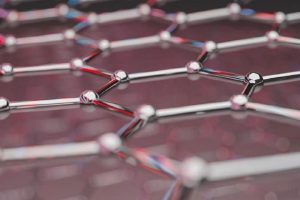
As they tested thick, laminated reactive foils of aluminum, zirconium, and carbon in the lab, Tim Weihs and Shane Arlington noticed some properties that baffled them. Weihs, a professor of materials science and engineering, and Arlington, a Draper PhD Fellow, were investigating materials that could be used to 3D print electrical components. But after heating the samples in a 1600 °C furnace and quenching them in water, the researchers observed some surprising behavior.
“Different products were formed when the material was heated slowly compared to when it was heated quickly,” said Arlington, now a scientist at Draper Labs. “The products we saw when heated quickly matched what we expected to see, based on published phase diagrams. But no matter what we did, when we heated the same material slowly, we obtained different products. That’s odd, because thermodynamically, we should be more likely to get the stable, equilibrium phases when going slow, not fast. We wanted to know if the published phase diagrams were erroneous or if there were some strange kinetics at play.”
Thousands of miles away, Karsten Woll, a professor at Karlsruhe Institute of Technology in southern Germany and a former postdoc in Weihs’ group at Hopkins, and his student Tobias Neuhauser, were developing techniques for testing a similar material. As they prepared to take their work to the Swiss Light Source, an X-ray synchrotron at the Paul Scherrer Institute in Villigen, Switzerland, Woll got in touch with Weihs about the work that was happening at Hopkins.
“We were coupling synchrotron X-ray diffraction with nanocalorimetry, two techniques that together allowed us to probe chemical reactions in solid state samples at extremely high rates. We wanted to expand that work and thought [the Weihs group] may have some desire to do similar experiments,” said Woll. So, Arlington set off for Switzerland to explore a potential collaboration.
“Though our initial goal was the creation of a material that could be 3D printed and had the ability to transforms through a self-propagating reaction from insulating to conductive and then stay stable at high temperatures, this potential collaboration also had the advantage of landing me at one of the premier synchrotron facilities in the world. What better place to solve this mystery?” said Arlington.
It took him more than a year to analyze the data he gathered from his time at the Swiss Light Source with Neuhauser and Woll.
And what it showed was surprising. Though the premise underlying the Hopkins team’s original decision to use reactive powders to print high-temperature stable electrical connections may have been faulty, Weihs and Arlington had gotten lucky. The final piece of the puzzle of explaining why their materials were not reacting as expected snapped into place with the timely publication of some unrelated density functional theory simulations.
“Had that not happened, we may still be scratching our heads,” said Arlington. “We verified that there is a critical rate at play in these materials. Above that rate we get what we expected, and slower than that, we get other products. But that only partially told us why. Those first principles simulations produced results at odds with the literature on the phase diagram, but they aligned with what we saw to a T.”
The room temperature equilibrium phases (what should exist at room temperature) weren’t what Weihs and Arlington thought, or what they wanted to make. But when formed rapidly at high temperatures and cooled quickly, they could ‘lock in’ the high-temperature phases that were previously thought to be the room-temperature ones. In addition to these findings confirming the efficacy of the 3D printing concept, Arlington characterized this discovery as a big wrap-up moment in this work, answering a fundamental question that bothered him from the beginning.
The paper detailing these findings was published in Materials & Design earlier this month.
Weihs credits Arlington with driving this project and with bringing together a critical set of collaborators: “without his drive, determination, and team building, we would not have been successful. In addition to Woll and Neuhauser in Germany, [Arlington] worked closely with Dr. David LaVan and other researchers at NIST to develop the nanocalorimeters used in the experiments. As Arlington notes, “I had my hands involved in all the experiments that went into this paper, but without the development of the sensors from Dr. LaVan or the test setup at the Swiss Light Source from Woll and Neuhauser, and some of the PSI staff, the crucial experiments would never have been possible,” says Arlington. “Since Woll and Neuhauser had already handled most of the experimental setup, it was a no-brainer to join in the proposal and I’m very grateful they asked us and that it spawned this wonderful collaboration.”